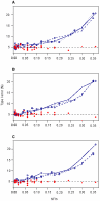True versus false parasite interactions: a robust method to take risk factors into account and its application to feline viruses
- PMID: 22235312
- PMCID: PMC3250451
- DOI: 10.1371/journal.pone.0029618
True versus false parasite interactions: a robust method to take risk factors into account and its application to feline viruses
Abstract
Background: Multiple infections are common in natural host populations and interspecific parasite interactions are therefore likely within a host individual. As they may seriously impact the circulation of certain parasites and the emergence and management of infectious diseases, their study is essential. In the field, detecting parasite interactions is rendered difficult by the fact that a large number of co-infected individuals may also be observed when two parasites share common risk factors. To correct for these "false interactions", methods accounting for parasite risk factors must be used.
Methodology/principal findings: In the present paper we propose such a method for presence-absence data (i.e., serology). Our method enables the calculation of the expected frequencies of single and double infected individuals under the independence hypothesis, before comparing them to the observed ones using the chi-square statistic. The method is termed "the corrected chi-square." Its robustness was compared to a pre-existing method based on logistic regression and the corrected chi-square proved to be much more robust for small sample sizes. Since the logistic regression approach is easier to implement, we propose as a rule of thumb to use the latter when the ratio between the sample size and the number of parameters is above ten. Applied to serological data for four viruses infecting cats, the approach revealed pairwise interactions between the Feline Herpesvirus, Parvovirus and Calicivirus, whereas the infection by FIV, the feline equivalent of HIV, did not modify the risk of infection by any of these viruses.
Conclusions/significance: This work therefore points out possible interactions that can be further investigated in experimental conditions and, by providing a user-friendly R program and a tutorial example, offers new opportunities for animal and human epidemiologists to detect interactions of interest in the field, a crucial step in the challenge of multiple infections.
Conflict of interest statement
Figures

Similar articles
-
Unknown age in health disorders: A method to account for its cumulative effect and an application to feline viruses interactions.Epidemics. 2015 Jun;11:48-55. doi: 10.1016/j.epidem.2015.02.004. Epub 2015 Feb 24. Epidemics. 2015. PMID: 25979281
-
When cats' ways of life interact with their viruses: a study in 15 natural populations of owned and unowned cats (Felis silvestris catus).Prev Vet Med. 2011 Sep 1;101(3-4):250-64. doi: 10.1016/j.prevetmed.2011.04.020. Epub 2011 Jun 25. Prev Vet Med. 2011. PMID: 21705099
-
[The parasite capacity of the host population].Parazitologiia. 2002 Jan-Feb;36(1):48-59. Parazitologiia. 2002. PMID: 11965643 Russian.
-
Viruses of parasites as actors in the parasite-host relationship: A "ménage à trois".Acta Trop. 2017 Feb;166:126-132. doi: 10.1016/j.actatropica.2016.11.028. Epub 2016 Nov 19. Acta Trop. 2017. PMID: 27876650 Review.
-
Role of the bovine immune system and genome in resistance to gastrointestinal nematodes.Vet Parasitol. 2001 Jul 12;98(1-3):51-64. doi: 10.1016/s0304-4017(01)00423-x. Vet Parasitol. 2001. PMID: 11516579 Review.
Cited by
-
The importance of multiparasitism: examining the consequences of co-infections for human and animal health.Parasit Vectors. 2015 Oct 20;8:545. doi: 10.1186/s13071-015-1167-9. Parasit Vectors. 2015. PMID: 26482351 Free PMC article. Review.
-
Co-occurrence of pathogen assemblages in a keystone species the common cockle Cerastoderma edule on the Irish coast.Parasitology. 2021 Nov;148(13):1665-1679. doi: 10.1017/S0031182021001396. Epub 2021 Jul 30. Parasitology. 2021. PMID: 35060462 Free PMC article.
-
To be or not to be associated: power study of four statistical modeling approaches to identify parasite associations in cross-sectional studies.Front Cell Infect Microbiol. 2014 May 15;4:62. doi: 10.3389/fcimb.2014.00062. eCollection 2014. Front Cell Infect Microbiol. 2014. PMID: 24860791 Free PMC article.
-
Interactions among urogenital, intestinal, skin, and oral infections in pregnant and lactating Panamanian Ngäbe women: a neglected public health challenge.Am J Trop Med Hyg. 2015 Jun;92(6):1100-10. doi: 10.4269/ajtmh.14-0547. Epub 2015 Mar 30. Am J Trop Med Hyg. 2015. PMID: 25825387 Free PMC article.
-
A probabilistic model in cross-sectional studies for identifying interactions between two persistent vector-borne pathogens in reservoir populations.PLoS One. 2013 Jun 20;8(6):e66167. doi: 10.1371/journal.pone.0066167. Print 2013. PLoS One. 2013. PMID: 23840418 Free PMC article.
References
-
- Cox FEG. Concomitant infections, parasites and immune responses. Parasitology. 2001;122:S23–S38. - PubMed
-
- Grmek MD. Préliminaires d'une étude historique des maladies. Annales. Economies, Sociétés, Civilisations. 1969;24:1473–1483.
-
- Rodriguez M, Terrazas LI, Marquez R, Bojalil R. Susceptibility to Trypanosoma cruzi is modified by a previous non-related infection. Parasite Immunol. 1999;21:177–185. - PubMed
-
- Lello J, Boag B, Fenton A, Stevenson IR, Hudson PJ. Competition and mutualism among the gut helminths of a mammalian host. Nature. 2004;428:840–844. - PubMed
-
- Graham AL, Lamb TJ, Read AF, Allen JE. Malaria-filaria coinfection in mice makes malarial disease more severe unless filarial infection achieves patency. J Infect Dis. 2005;191:410–421. - PubMed
Publication types
MeSH terms
LinkOut - more resources
Full Text Sources
Research Materials
Miscellaneous

